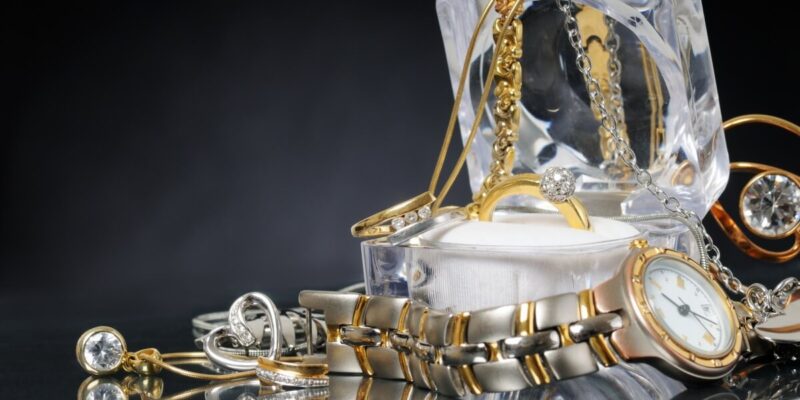Navigating the realm of secondhand jewelry can be a thrilling and rewarding experience, offering a unique blend of affordability and character that new pieces might lack. For those with a discerning eye and a taste for timeless treasures, pawn shops have become go-to destinations for sourcing exquisite jewelry that tells a story.
As you explore the vast array of options when considering secondhand jewelry purchases, it’s essential to pinpoint reputable pawn shops that stand out for their unique offerings.
Maxferd Jewelry & Loan has carved a niche as an exceptional pawn shop. In the bustling city of Los Angeles and the following areas:
Unique pawn shop selling and buying used jewelry in Los Angeles, CA
Offering the best used jewelry in Lawndale, CA
Reputable pawn shop selling and buying used jewelry in Woodland Hills, CA
Specializing in selling and buying used jewelry in San Francisco, CA
Meanwhile, in this exploration of the critical factors in purchasing secondhand jewelry from pawn shops, we delve into the nuances that can transform your shopping experience into a treasure hunt. Whether you’re a seasoned collector or a novice in vintage adornments, understanding these factors is paramount in making informed choices and uncovering hidden gems that resonate with style and history. Assessing Authenticity
Verifying Jewelry Materials and Composition
When delving into the world of used jewelry, an essential step is verifying the piece’s authenticity by closely examining its materials and composition. This involves identifying the type of metal used, such as gold or silver, and ensuring that it matches the seller’s description. Look for visible signs of wear or discoloration, which can provide valuable insights into the jewelry’s composition. Consider seeking a jeweler’s expertise to confirm the materials’ authenticity.
Examining Hallmarks and Certifications
To further solidify the authenticity of used jewelry, scrutinize any hallmarks or certifications on the piece. Hallmarks are minor marks stamped on jewelry that indicate the metal’s quality and origin. Certifications, on the other hand, may come from gemological laboratories and confirm the authenticity of gemstones. Thoroughly research and understand these marks, as they are valuable clues to the jewelry’s legitimacy. If you need more time, consult a reputable appraiser who can decipher these marks.
Ensuring Genuine Gemstones and Metals
Genuine gemstones enhance the allure of used jewelry, and ensuring their authenticity is paramount. Employ a magnifying glass to inspect gemstones closely, looking for imperfections that genuine stones typically have. Additionally, research the specific gemstone’s characteristics to identify any red flags. For metals, inquire about the presence of any alloys and verify their composition. A genuine piece will boast authentic gemstones and metals, contributing to its overall value and appeal.
Evaluating Condition
Scrutinizing Wear and Tear
The condition of used jewelry is pivotal in its value and longevity. Scrutinizing wear and tear involves closely examining the piece for any visible signs of damage or deterioration. Pay special attention to areas prone to friction, such as clasps and joints. While some wear is expected in used items, excessive damage may impact the jewelry’s structural integrity. Assessing wear and tear lets you decide about the piece’s overall condition and whether it aligns with your expectations.
Checking for Damages and Repairs
In addition to wear and tear, checking for damages and repairs provides a comprehensive understanding of the jewelry’s history. Examine the piece for any signs of previous repairs, such as soldering marks or alterations. While some repairs are routine maintenance, extensive or poorly executed repairs can diminish the piece’s value. Being aware of any past damages and repairs ensures transparency in the transaction and helps you evaluate the long-term durability of the jewelry.
Assessing Overall Aesthetic Appeal
Beyond technical assessments, the aesthetic appeal of used jewelry is crucial in determining its worth. Consider how the piece complements your style and preferences. Assess the craftsmanship, design intricacies, and artistic elements contributing to its visual appeal. A well-maintained and aesthetically pleasing piece can become a cherished addition to your collection, even if it shows minor wear. Balancing technical assessments with subjective appreciation ensures a well-rounded evaluation of the jewelry’s condition.
Understanding Appraisals and Valuations
Researching Current Market Values
Before finalizing a purchase, researching current market values provides insight into the fair price range for the used jewelry you are interested in. Explore online marketplaces, auction results, and reputable jewelry retailers to understand the prevailing market trends. Knowledge of current values empowers you to negotiate confidently, ensuring you secure a fair deal based on the jewelry’s intrinsic worth and market demand.
Seeking Professional Appraisals
While personal research is valuable, seeking professional appraisals adds a layer of expertise to the valuation process. A certified appraiser can more accurately assess the jewelry’s characteristics, condition, and market demand. Their impartial evaluation provides an unbiased perspective, helping you make an informed decision. Investing in a professional appraisal is a wise step, especially when dealing with high-value or unique pieces, as it ensures you receive an accurate valuation.
Negotiating Fair Pricing Based on Assessment
Armed with knowledge from market research and professional appraisals, negotiating fair pricing becomes a critical aspect of purchasing used jewelry. Engage openly with the seller, sharing your insights on the jewelry’s condition, materials, and market values. A fair negotiation considers both parties’ interests, leading to a mutually beneficial transaction. Being well-informed and confident in your assessment allows you to navigate the negotiation process clearly and ensures you receive value for your investment.
Knowledge of Pawn Shop Reputation
Investigating Shop History and Reputation
Investigating the shop’s history and reputation is paramount when purchasing used jewelry from a pawn shop. Look for established businesses with a positive track record in dealing with secondhand jewelry. A pawn shop with a reputable history is more likely to provide accurate information about the items they sell. Explore their years in business, customer satisfaction, and any notable achievements within the industry.
Reading Customer Reviews and Testimonials
To gain insights into the pawn shop’s reputation, delve into customer reviews and testimonials. Real experiences from previous buyers can offer valuable perspectives on the shop’s transparency, customer service, and the quality of its jewelry offerings. Pay attention to recurring themes in reviews and weigh the overall sentiment. A pawn shop with consistently positive feedback is more likely to uphold ethical practices and deliver a satisfactory buying experience.
Ensuring Transparent and Honest Transactions
Transparency and honesty are non-negotiable when dealing with used jewelry transactions at pawn shops. Ensure the pawnshop provides transparent information about each piece, including its condition, materials, and relevant history. A reputable shop will willingly disclose details and answer any questions you may have. By prioritizing transparent transactions, you establish trust with the pawn shop, fostering a positive and secure buying environment.
Negotiation Strategies
Developing a Clear Budget
When venturing into the world of used jewelry, setting a clear budget is paramount. Begin by evaluating your financial comfort zone, considering your income, savings, and other financial commitments. This will guide your purchasing decisions and streamline the negotiation process. Clearly defined budget parameters empower you as a buyer, ensuring that you make informed choices aligned with your financial goals. Moreover, it provides a basis for effective communication with sellers, establishing realistic expectations.
Understanding Price Flexibility
Understanding the dynamics of price flexibility is critical to successful negotiations when buying used jewelry. Sellers often expect a degree of haggling, so don’t hesitate to explore potential discounts. Research the market value of similar items to gauge the reasonable range for negotiation. Remember that the jewelry’s condition, brand, and rarity influence price flexibility. You can secure a better deal by approaching negotiations with a fair understanding of these variables. Remember, sellers appreciate well-informed and reasonable buyers in their negotiation approach.
Effective Communication for Win-Win Transactions
Effective communication forms the cornerstone of successful negotiations in the used jewelry domain. Clearly articulate your preferences and expectations while remaining open to the seller’s perspective. This collaborative approach fosters a win-win situation where both parties feel satisfied with the transaction. Respectful and courteous communication builds rapport and can influence the seller’s willingness to accommodate your requests. Be transparent about your budget constraints and preferences, creating a conducive environment for reaching mutually beneficial agreements.
Return and Exchange Policies
Familiarizing Yourself with Shop Policies
Before making a purchase, take the time to familiarize yourself with the shop’s return and exchange policies. Each establishment may have unique rules governing returns, and being aware of them is crucial for a seamless buying experience. Pay attention to conditions such as the return timeframe, acceptable reasons, and associated fees. By understanding these policies in advance, you mitigate the risk of unexpected complications and establish a foundation for a hassle-free transaction.
Clarifying Terms for Returns and Exchanges
When navigating the intricacies of return and exchange policies, clarifying any ambiguous terms with the seller is essential. Seek detailed information on the conditions under which returns are accepted and the process for initiating exchanges. This clarity safeguards your rights as a consumer and contributes to a transparent and trustworthy transaction. Knowing the specifics of the policy ensures that, in the rare event of dissatisfaction, you can navigate the process smoothly and confidently.
Ensuring Consumer Protection and Satisfaction
In the realm of used jewelry, consumer protection and satisfaction is a shared responsibility between buyers and sellers. Prioritize establishments prioritizing customer satisfaction through fair return policies and transparent communication. This commitment to consumer protection guarantees that your investment is secure and reinforces trust in the secondhand jewelry market. Additionally, consider reviews and testimonials from other buyers to gauge the overall satisfaction level with the shop’s policies and practices.
Maintenance and Care Tips
Implementing Proper Cleaning Practices
After acquiring used jewelry, proper cleaning practices are essential to maintain its luster and longevity. Depending on the material and gemstones, different cleaning methods may apply. Consult reputable sources or jewelers for guidance on suitable cleaning solutions and techniques. Regular cleaning enhances the aesthetic appeal and prevents the accumulation of dirt and oils that can damage the jewelry over time. By incorporating this simple yet effective practice, you contribute to preserving your investment.
Storing Secondhand Jewelry Safely
Proper storage is paramount in preserving the condition of secondhand jewelry. Invest in quality storage solutions such as jewelry boxes with individual compartments to prevent pieces from scratching against each other. Consider factors like humidity and exposure to sunlight, as these can impact the jewelry’s integrity. Storing jewelry in a cool, dry place, away from direct sunlight, ensures that it retains its beauty and minimizes the need for frequent cleaning or restoration.
Seeking Professional Maintenance Services When Necessary
Despite diligent care, secondhand jewelry may require professional maintenance services periodically. Establish a relationship with a reputable jeweler who specializes in servicing used pieces. Professional cleaning, inspection for loose stones, and setting adjustments can revitalize your jewelry and address potential issues before they escalate. Regular check-ups by a qualified professional contribute to the longevity of your secondhand treasures, offering peace of mind and sustained enjoyment.
Astute evaluation and informed decisions unlock a gratifying and enduring journey in the intricate world of used jewelry. Armed with insights into authenticity, condition assessments, and effective negotiation, buyers can confidently navigate the marketplace. As guardians of treasured pieces, understanding maintenance and care ensures a lasting legacy. This guide serves as a compass, empowering enthusiasts to explore the realm of secondhand jewelry with wisdom and enthusiasm, forging connections between the past and the present through each carefully chosen piece,













